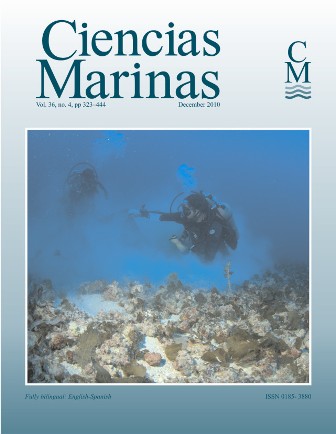Genetic variability of Crassostrea gigas and Crassostrea corteziensis from a hatchery in northwestern Mexico
Main Article Content
Abstract
To evaluate the genetic variability of oysters supplied by the Centro Reproductor de Especies Marinas del Estado de Sonora (Marine Species Hatchery Center of the State of Sonora), allozyme loci of triploid Crassostrea gigas (n = 78) and the F1 generation of a new batch of diploid native oyster Crassostrea corteziensis (n = 78) were analyzed. For the C. gigas sample, 10 enzymatic systems were analyzed, revealing 16 loci of which 12 were polymorphic. For C. corteziensis, 9 enzymatic systems revealed 13 loci, of which 8 were polymorphic. The average expected and observed heterozygosities for C. gigas were 0.350 and 0.309, respectively, with no significant differences between them. These figures are similar to those reported for wild diploid organisms, but lower than those reported for triploids. The average expected and observed heterozygosities for C. corteziensis were 0.294 and 0.065, with significant differences (P = 0.001). The phenotypic frequency analysis of the 12 polymorphic loci of C. gigas demonstrated that only 3 loci (AKP*, EST-2*, and PEP-1*) were in equilibrium according to the Hardy-Weinberg Law, with an average inbreeding of 0.133. For C. corteziensis, the 8 polymorphic loci were found outside of the Hardy-Weinberg Law, reflecting a high inbreeding value of 0.777 because of the large heterozygote deficiency in all loci, suggesting that the source broodstock is genetically eroded. If genetic variability is not considered in the selection of the broodstock, oyster culture in northwest Mexico will become unstable. We recommend a program of selection of diploid lineages of C. gigas with a good genetic variability and a good level of heterozygosis, and for C. corteziensis it is important to choose the wild population with the lowest inbreeding index in order to get a genetically healthy broodstock.
Downloads
Article Details
This is an open access article distributed under a Creative Commons Attribution 4.0 License, which allows you to share and adapt the work, as long as you give appropriate credit to the original author(s) and the source, provide a link to the Creative Commons license, and indicate if changes were made. Figures, tables and other elements in the article are included in the article’s CC BY 4.0 license, unless otherwise indicated. The journal title is protected by copyrights and not subject to this license. Full license deed can be viewed here.

